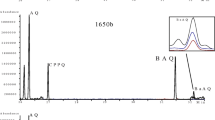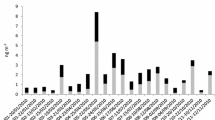Abstract
Diesel exhaust particulate matter contains many semivolatile organic compounds (SVOCs) of environmental and health significance. This study investigates the composition, emission rates, and measurement integrity of 25 SVOCs, including polycyclic aromatic hydrocarbons (PAHs), nitro-PAHs (NPAHs), and diesel biomarkers hopanes and steranes. Diesel engine particulate matter (PM), generated using an engine test bench, three engine conditions, and ultralow sulfur diesel (ULSD), was collected on borosilicate glass fiber filters. Under high engine load, the PM emission rate was 0.102 g/kWh, and emission rates of ΣPAHs (10 compounds), ΣNPAHs (6 compounds), Σhopanes (2 compounds), and Σsteranes (2 compounds) were 2.52, 0.351, 0.02–2 and 1 μg/kWh, respectively. Storage losses were evaluated for three cases: conditioning filters in clean air at 25 °C and 33 % relative humidity (RH) for 24 h, storing filter samples (without extraction) wrapped in aluminum foil at 4 °C for up to 1 month, and storing filter extracts in glass vials capped with Teflon crimp seals at 4 °C for up to 6 months. After conditioning filters for 24 h, 30 % of the more volatile PAHs were lost, but lower volatility NPAHs, hopanes and steranes showed negligible changes. Storing wrapped filters and extracts at 4 °C for up to 1 month did not lead to significant losses, but storing extracts for 5 months led to significant losses of PAHs and NPAHs; hopanes and steranes demonstrated greater integrity. These results suggest that even relatively brief filter conditioning periods, needed for gravimetric measurements of PM mass, and extended storage of filter extracts, can lead to underestimates of SVOC concentrations. Thus, SVOC sampling and analysis protocols should utilize stringent criteria and performance checks to identify and limit possible biases occurring during filter and extract processing.


Similar content being viewed by others
References
Alsberg, T., Stenberg, U., Westerholm, R., Strandell, M., Rannug, U., Sundvall, A., et al. (1985). Chemical and biological characterization of organic material from gasoline exhaust particles. Environmental Science & Technology, 19(1), 43–50.
ATSDR. (1995). Toxicological profile for polycyclic aromatic hydrocarbons (PAHs) (Update). Atlanta: Agency for Toxic Substances and Disease Registry.
CFR. (1982). Code of Federal Regulations Title 40 Part 423 Appendix A: 126 Priority Pollutants. Washington, D.C.: U.S. National Archives and Records Administration.
CFR. (2013). Code of federal regulations title 40 part 1065: engine testing procedures. Washington, D.C.: U.S. National Archives and Records Administration.
Chen, B., Xuan, X., Zhu, L., Wang, J., Gao, Y., Yang, K., et al. (2004). Distributions of polycyclic aromatic hydrocarbons in surface waters, sediments and soils of Hangzhou City, China. Water Research, 38(16), 3558–3568.
Dabrowska, D., Kot-Wasik, A., & Namiesnik, J. (2008). Stability studies of selected polycyclic aromatic hydrocarbons in different organic solvents and identification of their transformation products. Polish Journal of Environmental Studies, 17(1), 17–24.
Dusek, B., Hajskova, J., & Kocourek, V. (2002). Determination of nitrated polycyclic aromatic hydrocarbons and their precursors in biotic matrices. Journal of Chromatography. A, 982(1), 127–143.
EPA. (1996). Method 3542: extraction of semivolatile analytes collected using method 0010 (modified method 5 sampling train). Washington, D.C.: U.S. Environmental Protection Agency.
EPA. (2008). SW-846: test methods for evaluating solid waste, physical/chemical methods (3rd ed.). Washington, D.C.: U.S. Environmental Protection Agency.
Gambino, M., Iannaccone, S., Battistelli, C. L., Crebelli, R., Iamiceli, A. L., & Turrio Baldassarri, L. (2001). Exhaust emission toxicity evaluation for heavy duty diesel and natural gas engines. Part I: regulated and unregulated emissions with diesel fuel and a blend of diesel fuel and biodiesel. International Combustion Engines, SAE_NA Technical Paper Series 2001-01-044. doi:10.4271/2001-24-0044
Gerald Liu, Z., Berg, D. R., Vasys, V. N., Dettmann, M. E., Zielinska, B., & Schauer, J. J. (2010). Analysis of C1, C2, and C10 through C33 particle-phase and semi-volatile organic compound emissions from heavy-duty diesel engines. Atmospheric Environment, 44(8), 1108–1115.
Gorse, R., Jr., Salmeen, I., & Clark, C. (1982). Effects of filter loading and filter type on the mutagenicity and composition of diesel exhaust particulate extracts. Atmospheric Environment, 16(6), 1523–1528.
Grimmer, G. (1988). Quality guarantee of sampling procedure for polycyclic aromatic-hydrocarbons. Staub Reinhaltung Der Luft, 48(11), 401–404.
Hori, S., & Narusawa, K. (2001). The influence of fuel components on PM and PAH exhaust emissions from a DI diesel engine-effects of pyrene and sulfur contents. SAE Transactions, 110(4), 2386–2392.
ISO. (2009). ISO-DIS 16183: Heavy duty engines. Measurement of gaseous emissions from raw exhaust gas and of particulate emissions using partial flow dilution systems under transient test conditions. Geneva: International Organization for Standardization.
Khalek, I. A., Bougher, T. L., Merritt, P. M., & Zielinska, B. (2011). Regulated and unregulated emissions from highway heavy-duty diesel engines complying with US Environmental Protection Agency 2007 emissions standards. Journal of the Air & Waste Management Association (1995), 61(4), 427.
Kleeman, M. J., Riddle, S. G., Robert, M. A., & Jakober, C. A. (2007). Lubricating oil and fuel contributions to particulate matter emissions from light-duty gasoline and heavy-duty diesel vehicles. Environmental Science & Technology, 42(1), 235–242.
Kleiman, G., Graham, J., Savelli, E., & Bowen, R. S. (2003). Review of speciation trends network and IMPROVE chemically speciated data. Boston, MA: Northeast States for Coordinated Air Use Management.
Kloster, G., Niehaus, R., & Stania, H. (1992). Storage stability of polycyclic aromatic hydrocarbons collected from ambient air using solid supports. Fresenius' Journal of Analytical Chemistry, 342(4), 405–408.
Lea-Langton, A., Li, H., & Andrews, G. (2008). Comparison of particulate PAH emissions for diesel, biodiesel and cooking oil using a heavy duty DI diesel engine. SAE Technical Paper, 01-1811. doi:10.4271/2008-01-1811
Logan, D. T. (2007). Perspective on ecotoxicology of PAHs to fish. Human and Ecological Risk Assessment: An International Journal, 13(2), 302–316.
Neff, J. M. (1979). Polycyclic aromatic hydrocarbons in the aquatic environment. Sources, Fates and Biological Effects. London: Applied Science Publishers Ltd.
Oda, J., Yasuhara, A., Matsunaga, K., & Saito, Y. (1998). Stability of polycyclic aromatic hydrocarbons and their oxygenated derivatives during various storage.Japanese. Journal of Toxicology and Environmental Health, 44(5), 352–363.
Prince, R., & Walters, C. C. (2007). Biodegradation of oil hydrocarbons and its implications for source identification. In Z. Wang & S. Stout (Eds.), Oil spill environmental forensics (pp. 349–379). California: Academic Press.
Ratcliff, M. A., Dane, A. J., Williams, A., Ireland, J., Luecke, J., McCormick, R. L., et al. (2010). Diesel particle filter and fuel effects on heavy-duty diesel engine emissions. Environmental Science & Technology, 44(21), 8343–8349.
Rost, H., Loibner, A. P., Hasinger, M., Braun, R., & Szolar, O. H. J. (2002). Behavior of PAHs during cold storage of historically contaminated soil samples. Chemosphere, 49(10), 1239–1246.
Salmeen, I. T., Pero, A. M., Zator, R., Schuetzle, D., & Riley, T. L. (1984). Ames assay chromatograms and the identification of mutagens in diesel particle extracts. Environmental Science & Technology, 18(5), 375–382.
Schantz, M. M., Porter, B. J., & Wise, S. A. (2000). Stability of polycyclic aromatic hydrocarbons in frozen mussel tissue. Polycyclic Aromatic Compounds, 19(1), 253–262.
Schauer, J. J., Kleeman, M. J., Cass, G. R., & Simoneit, B. R. T. (1999). Measurement of emissions from air pollution sources. 2. C1 through C30 organic compounds from medium duty diesel trucks. Environmental Science & Technology, 33(10), 1578–1587.
Schauer, J. J., Kleeman, M. J., Cass, G. R., & Simoneit, B. R. T. (2002). Measurement of emissions from air pollution sources. 5. C1-C32 organic compounds from gasoline-powered motor vehicles. Environmental Science & Technology, 36(6), 1169–1180.
Sharp, C. A., Howell, S., & Jobe, J. (2000a). The effect of biodiesel fuels on transient emissions from modern diesel engines, part I: regulated emissions and performance. SAE Technical Paper 2000-01-1967. doi:10.4271/2000-01-1967
Sharp, C. A., Howell, S., & Jobe, J. (2000b). The effect of biodiesel fuels on transient emissions from modern diesel engines, part II unregulated emissions and chemical characterization. SAE Technical Paper 2000-01-1968. doi:10.4271/2000-01-1968
Sverdrup, G. M., Buxton, B. E., Chuang, J. C., & Casuccio, G. S. (1990). Determination of optimal storage conditions for particle samples. Environmental Science & Technology, 24(8), 1186–1195.
Tanaka, S., Takizawa, H., Shimizu, T., & Sanse, K. (1998). Effect of fuel compositions on PAH in particulate matter from DI diesel engine. SAE Transactions, 107, 1941–1951.
Vaessen, H. A. M. G., van de Kamp, C. G., & Jekel, A. A. (1988). Preparation and stability of ampouled polycyclic aromatic hydrocarbon solutions. Zeitschrift für Lebensmitteluntersuchung und-Forschung A, 186(4), 308–310.
Zinbo, M., Korniski, T. J., & Weir, J. E. (1995). Relationship between the composition of engine particulate emissions and emission control system performance. Industrial and Engineering Chemistry Research, 34(2), 619–625.
Acknowledgments
The authors thank the Walter E. Lay Auto Laboratory at the University of Michigan, and Mehdi Abarham, Tejas Chafekar, Ashwin Salvi, Feng-Chiao Su, and Dongyan Sun for laboratory assistance. This study was supported in part by the US Environmental Protection Agency grant GL00E00690-0 entitled “PAHs, Nitro-PAHs & Diesel Exhaust Toxics in the Great Lakes: Apportionments, Impacts and Risks.” Additional support to this research was provided by the grant P30ES017885 from the National Institute of Environmental Health Sciences, National Institutes of Health entitled “Lifestage Exposure and Adult Disease.”
Author information
Authors and Affiliations
Corresponding author
Electronic supplementary material
Below is the link to the electronic supplementary material.
ESM 1
(PDF 82 kb)
Rights and permissions
About this article
Cite this article
Huang, L., Bohac, S.V., Chernyak, S.M. et al. Composition and Integrity of PAHs, Nitro-PAHs, Hopanes, and Steranes in Diesel Exhaust Particulate Matter. Water Air Soil Pollut 224, 1630 (2013). https://doi.org/10.1007/s11270-013-1630-1
Received:
Accepted:
Published:
DOI: https://doi.org/10.1007/s11270-013-1630-1




